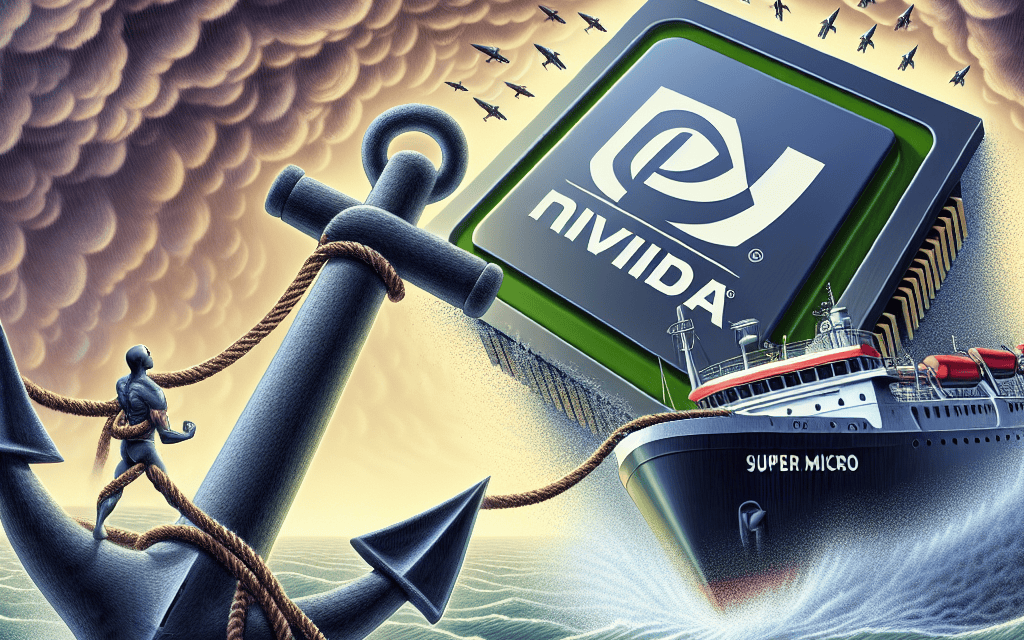“Navigating Survival: Super Micro’s Strategic Shift from NVIDIA Blackwell”
Introduction
Super Micro Computer, a prominent player in the high-performance computing and server solutions market, is facing a critical juncture as industry analysts suggest the company may need to reconsider its strategic alignment with NVIDIA’s Blackwell architecture to maintain financial stability. Amidst rapidly evolving technological landscapes and competitive pressures, Super Micro’s reliance on NVIDIA’s cutting-edge advancements has been a cornerstone of its product offerings. However, with shifting market dynamics and potential financial constraints, the company is now confronted with the challenging decision of whether to pivot away from this partnership to safeguard its operational viability. This potential strategic shift underscores the broader challenges faced by tech companies in balancing innovation with fiscal prudence in an increasingly volatile market environment.
Impact Of NVIDIA Blackwell On Super Micro’s Market Position
In the rapidly evolving landscape of technology, companies must continuously adapt to maintain their competitive edge. Super Micro, a prominent player in the server and storage solutions market, finds itself at a critical juncture as it navigates the potential impact of NVIDIA’s upcoming Blackwell architecture. This new development from NVIDIA, a leader in graphics processing units (GPUs) and artificial intelligence (AI) technologies, poses both opportunities and challenges for Super Micro. As analysts weigh in on the situation, some suggest that Super Micro might need to reconsider its reliance on NVIDIA’s Blackwell to ensure its long-term viability.
NVIDIA’s Blackwell architecture is anticipated to bring significant advancements in computational power and efficiency, promising to revolutionize AI and machine learning applications. For companies like Super Micro, which integrate NVIDIA’s GPUs into their server solutions, this could initially seem like a boon. The enhanced capabilities of Blackwell could enable Super Micro to offer more powerful and efficient products, potentially attracting a broader customer base. However, the competitive landscape is not solely defined by technological advancements; market dynamics and strategic positioning also play crucial roles.
One of the primary concerns for Super Micro is the potential commoditization of server hardware as NVIDIA’s Blackwell becomes more widely adopted. As more companies integrate Blackwell into their offerings, the differentiation between products may diminish, leading to increased price competition. This scenario could pressure Super Micro’s profit margins, making it challenging to sustain its market position. Furthermore, the reliance on a single supplier for critical components like GPUs can expose Super Micro to supply chain vulnerabilities and pricing fluctuations, which could further impact its financial stability.
In light of these challenges, some analysts argue that Super Micro should consider diversifying its product portfolio and reducing its dependency on NVIDIA’s Blackwell. By exploring alternative technologies and partnerships, Super Micro could mitigate the risks associated with over-reliance on a single supplier. This strategic shift could involve investing in research and development to create proprietary solutions or collaborating with other technology providers to offer unique, differentiated products. Such a move would not only help Super Micro maintain its competitive edge but also position it as a more resilient player in the market.
Moreover, the broader industry trend towards edge computing and decentralized data processing presents another avenue for Super Micro to explore. By focusing on developing solutions tailored to these emerging markets, Super Micro could tap into new revenue streams and reduce its exposure to the highly competitive central data center market. This strategic pivot would require a careful assessment of market needs and a willingness to innovate, but it could ultimately strengthen Super Micro’s market position.
In conclusion, while NVIDIA’s Blackwell architecture presents exciting opportunities for technological advancement, it also poses significant challenges for companies like Super Micro. To navigate this complex landscape, Super Micro may need to reassess its strategic priorities and consider diversifying its product offerings. By doing so, the company can better position itself to withstand market pressures and capitalize on emerging trends. As the technology sector continues to evolve, adaptability and strategic foresight will be crucial for Super Micro to remain a formidable player in the industry.
Strategic Alternatives For Super Micro Amidst NVIDIA Blackwell Challenges
In the rapidly evolving landscape of technology, companies must continuously adapt to maintain their competitive edge. Super Micro, a prominent player in the server and storage solutions market, is currently facing a significant strategic dilemma. The emergence of NVIDIA’s Blackwell architecture has introduced new challenges that could potentially disrupt Super Micro’s business model. As analysts scrutinize the situation, some suggest that Super Micro might need to reconsider its reliance on NVIDIA’s latest offerings to ensure its long-term viability.
NVIDIA’s Blackwell architecture represents a leap forward in processing power and efficiency, promising to revolutionize the capabilities of data centers and high-performance computing environments. While this advancement is undoubtedly a boon for the industry, it poses a unique challenge for Super Micro. The company has historically relied on NVIDIA’s technology to enhance its product offerings, integrating NVIDIA’s GPUs into its server solutions to meet the demands of customers seeking cutting-edge performance. However, the rapid adoption of Blackwell by competitors could potentially erode Super Micro’s market share if it fails to differentiate itself.
In light of these developments, analysts are urging Super Micro to explore strategic alternatives that could mitigate the risks associated with an over-reliance on NVIDIA’s technology. One potential avenue is diversifying its partnerships and product portfolio. By collaborating with other semiconductor manufacturers, Super Micro could reduce its dependency on a single supplier and offer a broader range of solutions to its customers. This approach would not only enhance its resilience against supply chain disruptions but also position the company to capitalize on emerging trends in the industry.
Moreover, investing in research and development to innovate proprietary technologies could provide Super Micro with a competitive edge. By developing its own unique solutions, the company could differentiate itself from competitors who are also leveraging NVIDIA’s Blackwell architecture. This strategy would require significant investment and a long-term commitment, but it could ultimately lead to greater control over its product offerings and a stronger market position.
Additionally, Super Micro might consider expanding its focus beyond traditional server solutions. The rise of edge computing and the Internet of Things (IoT) presents new opportunities for growth. By tapping into these emerging markets, Super Micro could diversify its revenue streams and reduce its vulnerability to shifts in the high-performance computing sector. This strategic pivot would necessitate a reevaluation of its current business model and a willingness to explore new avenues for innovation.
Furthermore, enhancing customer relationships and providing exceptional service could serve as a differentiator in a competitive market. By prioritizing customer satisfaction and building strong partnerships, Super Micro can foster loyalty and create a buffer against the volatility of technological advancements. This customer-centric approach would not only strengthen its brand reputation but also provide valuable insights into evolving customer needs and preferences.
In conclusion, the challenges posed by NVIDIA’s Blackwell architecture necessitate a strategic reassessment for Super Micro. While the allure of cutting-edge technology is undeniable, the company must carefully weigh the risks and benefits of continuing its reliance on NVIDIA’s offerings. By exploring diversification, investing in innovation, expanding into new markets, and prioritizing customer relationships, Super Micro can navigate the complexities of the current landscape and position itself for sustained success. As the technology sector continues to evolve, adaptability and foresight will be crucial for companies seeking to thrive amidst change.
Financial Implications Of Abandoning NVIDIA Blackwell For Super Micro
In the rapidly evolving landscape of technology, companies must constantly adapt to maintain their competitive edge. Super Micro, a prominent player in the server and storage solutions market, is currently facing a critical decision that could significantly impact its financial health. An analyst has recently suggested that Super Micro might need to abandon its partnership with NVIDIA’s Blackwell architecture to ensure its long-term viability. This recommendation stems from a complex interplay of market dynamics, financial considerations, and strategic foresight.
To begin with, NVIDIA’s Blackwell architecture represents a significant advancement in the realm of graphics processing units (GPUs), promising enhanced performance and efficiency. However, the integration of such cutting-edge technology comes with substantial costs. For Super Micro, aligning with Blackwell means committing to a high level of investment in research and development, as well as in the production processes required to support this sophisticated technology. While the potential benefits of such an alliance are undeniable, the financial burden it imposes cannot be overlooked.
Moreover, the competitive landscape in which Super Micro operates is characterized by rapid technological advancements and fierce competition. Companies are under constant pressure to innovate and deliver superior products to capture market share. In this context, the decision to partner with NVIDIA’s Blackwell could be a double-edged sword. On one hand, it positions Super Micro at the forefront of technological innovation, potentially attracting a niche market of high-performance computing enthusiasts. On the other hand, the financial strain of maintaining such a partnership could divert resources away from other critical areas of the business, such as expanding its product line or enhancing customer service.
Furthermore, the broader economic environment adds another layer of complexity to this decision. With global supply chain disruptions and fluctuating demand patterns, companies are increasingly cautious about making large-scale investments. For Super Micro, the uncertainty surrounding the global economy could exacerbate the risks associated with a continued partnership with NVIDIA’s Blackwell. In such a volatile market, maintaining financial flexibility is crucial, and committing to a costly technological alliance could limit the company’s ability to respond to unforeseen challenges.
In light of these considerations, the analyst’s suggestion to abandon NVIDIA Blackwell is rooted in a strategic assessment of Super Micro’s long-term financial health. By redirecting resources away from this high-cost partnership, Super Micro could potentially strengthen its financial position and invest in areas that offer more immediate returns. This could include diversifying its product offerings, enhancing operational efficiency, or exploring new markets. Such a strategy would not only mitigate financial risks but also position Super Micro to capitalize on emerging opportunities in the technology sector.
In conclusion, the decision to abandon NVIDIA Blackwell is not one to be taken lightly. It involves weighing the potential benefits of cutting-edge technology against the financial implications of such a commitment. For Super Micro, the path forward requires a careful balance between innovation and financial prudence. By considering the broader market dynamics and aligning its strategy with long-term financial goals, Super Micro can navigate this challenging landscape and ensure its continued success in the competitive world of technology.
Competitive Landscape: Super Micro Vs. NVIDIA Blackwell

In the rapidly evolving landscape of technology, companies must constantly adapt to maintain their competitive edge. Super Micro, a prominent player in the server and storage solutions market, finds itself at a critical juncture as it navigates the challenges posed by NVIDIA’s Blackwell architecture. An analyst recently suggested that Super Micro might need to reconsider its reliance on NVIDIA’s Blackwell to ensure its long-term viability. This recommendation stems from the increasingly competitive environment and the strategic decisions that Super Micro must make to sustain its market position.
NVIDIA’s Blackwell architecture represents a significant leap forward in computing power and efficiency, offering unparalleled performance for artificial intelligence and machine learning applications. As a result, many companies have eagerly integrated Blackwell into their systems to capitalize on its capabilities. However, this widespread adoption has also intensified competition, as businesses vie to offer the most advanced solutions to their customers. In this context, Super Micro’s dependence on Blackwell could potentially limit its ability to differentiate itself from competitors who are also leveraging the same technology.
Moreover, the reliance on a single supplier for critical components can expose a company to various risks, including supply chain disruptions and pricing pressures. By continuing to depend heavily on NVIDIA’s Blackwell, Super Micro may find itself vulnerable to fluctuations in availability and cost, which could impact its profitability and operational stability. Therefore, diversifying its technology portfolio could be a prudent strategy for Super Micro to mitigate these risks and enhance its resilience in the face of market uncertainties.
Furthermore, the competitive landscape is not solely defined by technological advancements but also by the ability to innovate and offer unique value propositions. Super Micro has historically been recognized for its ability to deliver customized solutions tailored to specific customer needs. By exploring alternative technologies and partnerships, the company could potentially develop new offerings that set it apart from competitors relying on Blackwell. This approach would not only help Super Micro maintain its competitive edge but also enable it to capture new market segments and expand its customer base.
In addition to technological considerations, financial implications also play a crucial role in strategic decision-making. The costs associated with integrating and supporting NVIDIA’s Blackwell could strain Super Micro’s resources, particularly if the company is unable to achieve the desired return on investment. By reallocating resources towards the development of proprietary technologies or collaborations with other industry players, Super Micro could optimize its financial performance and ensure sustainable growth.
While the suggestion to abandon NVIDIA’s Blackwell may seem drastic, it underscores the importance of strategic agility in a rapidly changing industry. Super Micro must carefully evaluate its options and consider the long-term implications of its technology choices. By proactively addressing the challenges posed by the competitive landscape, the company can position itself for continued success and remain a formidable player in the server and storage solutions market.
In conclusion, the recommendation for Super Micro to potentially abandon NVIDIA’s Blackwell highlights the complex interplay between technology, competition, and strategic decision-making. As the company navigates this dynamic environment, it must weigh the benefits and risks associated with its reliance on Blackwell and explore alternative paths to ensure its long-term viability. By embracing innovation and diversification, Super Micro can strengthen its competitive position and secure its future in an increasingly competitive industry.
Analyst Predictions: Super Micro’s Future Without NVIDIA Blackwell
In the rapidly evolving landscape of technology, companies must constantly adapt to maintain their competitive edge. Super Micro, a prominent player in the server and storage solutions market, is currently facing a pivotal moment in its strategic planning. An analyst has recently suggested that Super Micro might need to reconsider its reliance on NVIDIA’s Blackwell GPUs to ensure its long-term viability. This recommendation comes amid growing concerns about market dynamics and the increasing competition in the high-performance computing sector.
To understand the implications of this suggestion, it is essential to consider the context in which Super Micro operates. The company has long been known for its innovative server solutions, which cater to a wide range of industries, including data centers, cloud computing, and artificial intelligence. NVIDIA’s GPUs, particularly the Blackwell series, have been integral to Super Micro’s offerings, providing the computational power necessary for demanding applications. However, the analyst’s recommendation to potentially abandon Blackwell is not without reason.
One of the primary factors driving this suggestion is the intensifying competition in the GPU market. Companies like AMD and Intel are making significant strides in developing their own high-performance GPUs, which could offer viable alternatives to NVIDIA’s products. As these competitors continue to innovate, Super Micro may find itself in a position where diversifying its GPU partnerships could be beneficial. By exploring collaborations with other GPU manufacturers, Super Micro could mitigate the risks associated with over-reliance on a single supplier and enhance its ability to offer competitive solutions.
Moreover, the financial implications of maintaining a partnership with NVIDIA cannot be overlooked. The cost of integrating NVIDIA’s Blackwell GPUs into Super Micro’s systems is substantial, and any fluctuations in pricing or supply chain disruptions could have a significant impact on the company’s bottom line. By diversifying its GPU sources, Super Micro could potentially reduce costs and improve its financial stability, allowing it to allocate resources more effectively across its product lines.
In addition to financial considerations, technological advancements in the GPU industry are also influencing this strategic recommendation. The rapid pace of innovation means that new GPU architectures are continually being developed, each offering unique features and capabilities. By exploring alternative GPU options, Super Micro could leverage cutting-edge technologies that align more closely with its customers’ evolving needs. This flexibility would enable the company to tailor its solutions more precisely, thereby enhancing its competitive position in the market.
Furthermore, the analyst’s suggestion underscores the importance of strategic agility in the technology sector. Companies that can swiftly adapt to changing market conditions and technological advancements are more likely to thrive in the long term. For Super Micro, this may mean reevaluating its partnerships and exploring new opportunities that align with its strategic goals. While the decision to potentially abandon NVIDIA’s Blackwell GPUs is not without risks, it could ultimately position Super Micro for sustained growth and success.
In conclusion, the analyst’s recommendation for Super Micro to consider moving away from NVIDIA’s Blackwell GPUs highlights the complex interplay of market dynamics, financial considerations, and technological advancements. By carefully evaluating its options and remaining open to new partnerships, Super Micro can navigate these challenges and continue to deliver innovative solutions to its customers. As the technology landscape continues to evolve, strategic agility will be key to ensuring Super Micro’s future success.
Technological Shifts: How Super Micro Can Adapt Post-NVIDIA Blackwell
In the rapidly evolving landscape of technology, companies must continuously adapt to maintain their competitive edge. Super Micro, a prominent player in the server and storage solutions market, is currently facing a pivotal moment. An analyst has recently suggested that the company might need to reconsider its reliance on NVIDIA’s Blackwell GPUs to ensure its long-term viability. This recommendation comes amid significant shifts in the technological ecosystem, where agility and strategic foresight are paramount.
NVIDIA’s Blackwell architecture, known for its high-performance capabilities, has been a cornerstone for many companies, including Super Micro, in delivering cutting-edge solutions. However, the analyst’s suggestion to potentially abandon this partnership is not without reason. The technology sector is witnessing a surge in alternative solutions that promise similar, if not superior, performance metrics. These emerging technologies are not only cost-effective but also offer greater flexibility, which is crucial for companies looking to diversify their product offerings and reduce dependency on a single supplier.
Transitioning away from NVIDIA’s Blackwell could open new avenues for Super Micro, allowing it to explore partnerships with other innovative companies. By doing so, Super Micro could tap into a broader range of technologies, such as those based on open-source architectures or custom-designed chips tailored to specific industry needs. This strategic pivot could enhance Super Micro’s ability to cater to a diverse clientele, ranging from cloud service providers to enterprise data centers, each with unique requirements.
Moreover, the shift away from a singular reliance on NVIDIA could also mitigate risks associated with supply chain disruptions. In recent years, the global semiconductor shortage has underscored the vulnerabilities inherent in over-dependence on a limited number of suppliers. By diversifying its technology base, Super Micro could better insulate itself from such disruptions, ensuring a more resilient supply chain and consistent product delivery.
Furthermore, embracing a broader technological portfolio could position Super Micro as a leader in sustainability. As environmental concerns become increasingly central to corporate strategies, the ability to offer energy-efficient solutions is becoming a competitive differentiator. By exploring alternative technologies, Super Micro could develop products that not only meet performance expectations but also align with the growing demand for sustainable computing solutions.
However, this transition is not without its challenges. Moving away from a well-established partnership with NVIDIA requires careful planning and execution. Super Micro must invest in research and development to ensure that any new technologies it adopts are seamlessly integrated into its existing product lines. Additionally, the company must engage in strategic marketing efforts to communicate the benefits of its new offerings to its customer base, ensuring that clients understand the value proposition of the transition.
In conclusion, while the suggestion to abandon NVIDIA’s Blackwell may seem drastic, it presents an opportunity for Super Micro to redefine its position in the technology market. By embracing a more diversified technological approach, the company can enhance its resilience, expand its market reach, and align with contemporary demands for sustainability. As the technological landscape continues to shift, Super Micro’s ability to adapt will be crucial in determining its future success. Through strategic foresight and innovation, the company can navigate these changes and emerge stronger in the face of evolving industry dynamics.
Case Studies: Companies That Thrived After Abandoning Major Partnerships
In the ever-evolving landscape of technology, companies often face critical decisions that can determine their future trajectory. One such company, Super Micro, is currently at a crossroads, as analysts suggest it might need to abandon its partnership with NVIDIA Blackwell to remain viable. This situation is not unique, as history provides numerous examples of companies that have thrived after severing ties with major partners. Understanding these case studies can offer valuable insights into the potential outcomes for Super Micro.
To begin with, it is essential to recognize the significance of strategic partnerships in the tech industry. These alliances often provide companies with access to cutting-edge technology, expanded market reach, and shared resources. However, they can also lead to dependency, limiting a company’s ability to innovate independently. In the case of Super Micro, its collaboration with NVIDIA Blackwell has been instrumental in advancing its product offerings. Nevertheless, the rapidly changing market dynamics and increasing competition necessitate a reevaluation of this partnership.
Examining past instances where companies have successfully navigated similar challenges can shed light on potential strategies for Super Micro. For example, consider the case of IBM, which in the early 2000s decided to divest its personal computer division, a move that involved ending its long-standing partnership with Intel. This decision allowed IBM to focus on its core competencies in enterprise solutions and cloud computing, ultimately leading to a resurgence in its business performance. By prioritizing its strengths, IBM was able to adapt to the shifting technological landscape and emerge as a leader in its chosen domains.
Similarly, Apple’s decision to transition away from its reliance on PowerPC processors in favor of its own custom-designed chips marked a turning point for the company. This strategic shift not only enhanced Apple’s control over its product development but also resulted in significant performance improvements and cost efficiencies. The move underscored the importance of aligning technological capabilities with business objectives, a lesson that could be pertinent for Super Micro as it contemplates its future direction.
Moreover, the case of Nokia provides another compelling example. Once a dominant player in the mobile phone market, Nokia faced declining fortunes due to its partnership with Microsoft and the Windows Phone platform. Recognizing the need for a strategic pivot, Nokia eventually sold its mobile division and refocused on network infrastructure and technology licensing. This decision enabled Nokia to regain its footing and become a key player in the telecommunications industry once again.
These examples illustrate that while abandoning a major partnership can be fraught with risks, it can also present opportunities for reinvention and growth. For Super Micro, the decision to potentially part ways with NVIDIA Blackwell should be guided by a thorough assessment of its long-term goals and market positioning. By leveraging its existing strengths and exploring new avenues for innovation, Super Micro could chart a path toward sustained success.
In conclusion, the notion that Super Micro might need to abandon its partnership with NVIDIA Blackwell is not without precedent. As demonstrated by companies like IBM, Apple, and Nokia, strategic realignment can lead to renewed vitality and competitiveness. By learning from these case studies, Super Micro can make informed decisions that align with its vision for the future, ensuring its continued relevance in the ever-changing tech industry.
Q&A
1. **What is the main concern for Super Micro regarding NVIDIA Blackwell?**
– The main concern is that Super Micro might face financial difficulties if it continues to invest heavily in NVIDIA Blackwell without seeing sufficient returns.
2. **Why might Super Micro consider abandoning NVIDIA Blackwell?**
– Super Micro might consider abandoning NVIDIA Blackwell to avoid potential financial strain and to focus on more profitable ventures.
3. **What role does NVIDIA Blackwell play in Super Micro’s strategy?**
– NVIDIA Blackwell is part of Super Micro’s strategy to leverage cutting-edge technology for growth, but it poses financial risks if not managed properly.
4. **What are analysts suggesting Super Micro should do?**
– Analysts suggest that Super Micro should reassess its investment in NVIDIA Blackwell and possibly abandon it to maintain financial stability.
5. **How could abandoning NVIDIA Blackwell benefit Super Micro?**
– Abandoning NVIDIA Blackwell could free up resources and capital for Super Micro to invest in more promising and less risky opportunities.
6. **What are the potential risks of continuing with NVIDIA Blackwell for Super Micro?**
– The potential risks include financial losses, resource drain, and the possibility of not achieving the expected technological advancements or market share.
7. **What alternatives might Super Micro explore if it abandons NVIDIA Blackwell?**
– Super Micro might explore partnerships with other technology providers, invest in different product lines, or focus on optimizing existing operations to enhance profitability.
Conclusion
The conclusion is that Super Micro may need to reconsider its reliance on NVIDIA’s Blackwell chips to maintain financial stability. If the partnership with NVIDIA does not yield the expected benefits or becomes financially burdensome, Super Micro might have to explore alternative strategies or partnerships to ensure its continued viability and competitiveness in the market. This could involve diversifying its product offerings, seeking collaborations with other technology providers, or optimizing its operational efficiencies to reduce costs and enhance profitability.





